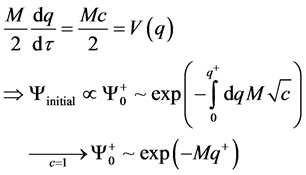Examination of Schrodinger Equation in Pre-Planckian Space-Time Early Universe ()
1. Vuilli Treatment of Schrodinger Equation for Curved Space-Time
Here, we bring up [1] , and a reset of the Schrodinger equation in early space-time, with curvature.
In [1] we start with
 (1)
(1)
Through the following substitutions,
 (2)
(2)
Then, after more derivation [1] obtained, with using the Ricci tensor  the following result: [2]
the following result: [2]
 (3)
(3)
2. Simplifying Equation (3) in Pre-Planckian Space-Time
We will re write Equation (3) to read as follows, with the result that in Pre-Planckian space-time
 (4)
(4)
Ricci tensor  in this setting becomes a constant, and is part of how the wave function evolves, and our candidate wave functional takes the form of
in this setting becomes a constant, and is part of how the wave function evolves, and our candidate wave functional takes the form of
 (5)
(5)
We will be identifying what to put into [3] , i.e., the Ricci scalar as given in Pre- Planckian space-time
 (6)
(6)
We are assuming that the term  approaches zero in Pre-Planckian space- time. Obviously if it did not, the last term
approaches zero in Pre-Planckian space- time. Obviously if it did not, the last term  would be dominant.
would be dominant.
Having said this, with an evolutionary equation statement as to the phase value of , it is time to look at the initial
, it is time to look at the initial  and to try to learn some physics from it.
and to try to learn some physics from it.
3. Defining the Initial Value Yinitial of Equation (5)
In order to do this, it may be useful to look at the classical degeneracy argument for forming , and the reference by Rubakov may be useful for this [4] i.e. using a false vacuum analogy, we can write, if q is a generalized space-time unit of “length”, and we examine a quartic potential, i.e. look at
, and the reference by Rubakov may be useful for this [4] i.e. using a false vacuum analogy, we can write, if q is a generalized space-time unit of “length”, and we examine a quartic potential, i.e. look at
 (7)
(7)
Now, use the usual given
 (8)
(8)
If using Ng infinite quantum statistics, [5] , and a non zero massive graviton mass (massive gravity) [6]
 (9)
(9)
And if we have here that  is in some sense proportional to length less than or equal to Planck length, the astonishing conclusion is that Equation (8) would probably be biased toward a low ( nonzero) entropy count, which would mean for finite initial entropy, connected with information transfer, that we would through Equation (8) and Equation (9) have a bias toward initially low, say 105 or so initial entropy, as a way to quantify the input into the formation of an initial wavefunction, using entropy as equivalent to information as given by Lloyd [7] .
is in some sense proportional to length less than or equal to Planck length, the astonishing conclusion is that Equation (8) would probably be biased toward a low ( nonzero) entropy count, which would mean for finite initial entropy, connected with information transfer, that we would through Equation (8) and Equation (9) have a bias toward initially low, say 105 or so initial entropy, as a way to quantify the input into the formation of an initial wavefunction, using entropy as equivalent to information as given by Lloyd [7] .
4. Comparing the Inputs into Equation (5), Equation (6), Equation (8) and Equation (9) against Force against Individual “Gravitons” in the Pre-Planckian Space-Time
We will go to the [3] reference, page 85, in order to look at a change in the stress energy tensor,
 (10)
(10)
Using this, and stating that in the Pre-Planckian regime of space-time due to [8] , that![]() , then if so, using [3] and [8]
, then if so, using [3] and [8]
![]() (11)
(11)
Here, we have that the initial volume ![]() would be less than the cube power of a Planck length [9] , but not zero, whereas the initial time would be less than, Planck time, but not equal to zero, [9] . For our analysis in the Pre-Planckian regime, we will specify
would be less than the cube power of a Planck length [9] , but not zero, whereas the initial time would be less than, Planck time, but not equal to zero, [9] . For our analysis in the Pre-Planckian regime, we will specify ![]() as the square of a nonzero initial scale factor for a nonsingular regime of space-time for General relativity with a value as given by [10] , and elaborated upon in [11] . In addition we have that the inflaton, as given in Equation (11) is explained in context by [12] , and we will use an argument below as to how a nonzero graviton mass is linkable to a non zero initial radii, which in turn will state that it is highly unlikely that
as the square of a nonzero initial scale factor for a nonsingular regime of space-time for General relativity with a value as given by [10] , and elaborated upon in [11] . In addition we have that the inflaton, as given in Equation (11) is explained in context by [12] , and we will use an argument below as to how a nonzero graviton mass is linkable to a non zero initial radii, which in turn will state that it is highly unlikely that ![]() which is proportional to a radial distance, cubed, goes to zero.. Note that Equation (11) is also an argument as to why there would be a finite, not almost “infinite” initial value of entropy, so then that Equation (8) would not go to zero.
which is proportional to a radial distance, cubed, goes to zero.. Note that Equation (11) is also an argument as to why there would be a finite, not almost “infinite” initial value of entropy, so then that Equation (8) would not go to zero.
Having said that, let us use a semi classical argument as to why the radii would not go to zero, even in Pre-Planckian space-time. This would be to insure that ![]() would not go to zero, even in Pre-Planckian space-time
would not go to zero, even in Pre-Planckian space-time
5. What Is Important about the Modified Poissons Equation [12] ? Getting a Non Zero Initial DV(3)
We will first of all refer to two necessary and sufficient conditions for the onset of a massive graviton given in [13] , and combined with Padmanablan’s reference [12] .
i.e. what we will be doing is to re do the reference calculations given in [13] with
![]() (12)
(12)
Here, we will be using in the Pre-Planckian potential the inputs from the data usually associated with [12]
![]() (13)
(13)
In other words, we will be using the inflation given by
![]() (14)
(14)
If so, then
![]() (15)
(15)
Then, after algebra, we have the following, from [14]
![]() (16)
(16)
The quadratic Equation this engenders is, how to say
![]() (17)
(17)
A candidate for the density functional will come next, with the way of obtaining a critical value for r is given by [14] as follows, i.e. if
![]() (18)
(18)
As far as applications to: [1]
![]() (19)
(19)
This would, lend itself to a quadratic equation for r, and the cube of r would be proportional to ![]() which would be non zero, in Pre-Planckian space-time conditions.
which would be non zero, in Pre-Planckian space-time conditions.
6. Comparing the Results of a Non Zero DV(3) in Pre-Planckian Wave Functional for Equation (8) against De Broglie-Bohmian Path of a Wave Functional
What we are examining if our qualitative argument which in sum yields a Pre- Planckian wavefunction as compared against the construction given in [15] which is in spirit comparable, up to a point with [16]
According to [15] we would have
![]() (20)
(20)
Here, ![]() would be the same as Equation (7), whereas we have V as given by Equation (18), and then we have
would be the same as Equation (7), whereas we have V as given by Equation (18), and then we have
![]() (21)
(21)
Here, if we use![]() , and have
, and have ![]() as given by Equation (8) whereas we find
as given by Equation (8) whereas we find
![]() (22)
(22)
Here, M would be given by Equation (9), i.e. and V were given by Equation (18) we would find to a point that
![]() (23)
(23)
i.e. the term ![]() would likely be the same, but interesting enough,
would likely be the same, but interesting enough, ![]() would likely be almost zero, i.e. not contributing at all.
would likely be almost zero, i.e. not contributing at all.
7. Conclusion, Overlap with the Bohmian Quantum Picture of Physics If Equation (24) Is Confirmed for Pre-Planckian Space-Time
The question to ask, is the following true? This has to be confirmed rigorously.
![]() (24)
(24)
The significance of proving or falsifying Equation (24) will in the end be part of future data analysis which should not contravene [17] [18] [19] . i.e. the experimentally implied limits should be adhered to and studied rigorously.
Furthermore, we have that analysis of Equation (24) may be in tandem with analysis of the Corda paper [20] as to if gravity is possibly scalar-tensor, an extension of GR (possibly with some semi classical treatment of presumed quantum gravity formulations), or something else.
Finally, since our paper is with respect to relic conditions, if so, then if we are to use a variant of interferometer methods, reference [21] and [22] if relic conditions are observable, via some form of space bound system, may allow us to with refinements get enough control of stochastic noise contamination of GW and the foot print of massive gravity to come up with confirmable data sets as to early universe conditions. With luck, with considerable refinement of instrumentation, we may also be able to get experimental confirmation of [23] and its predictions as to inflaton physics and possibly massive gravity.
Acknowledgements
This work is supported in part by National Nature Science Foundation of China grant No. 11375279.